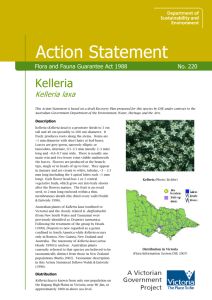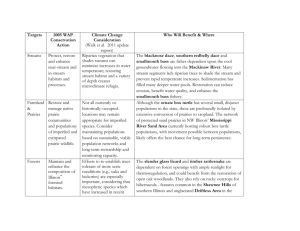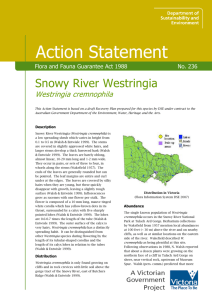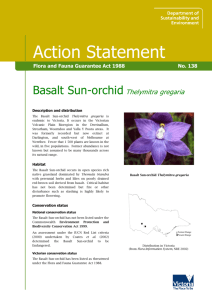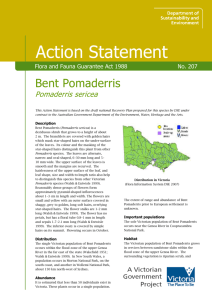Habitat
advertisement
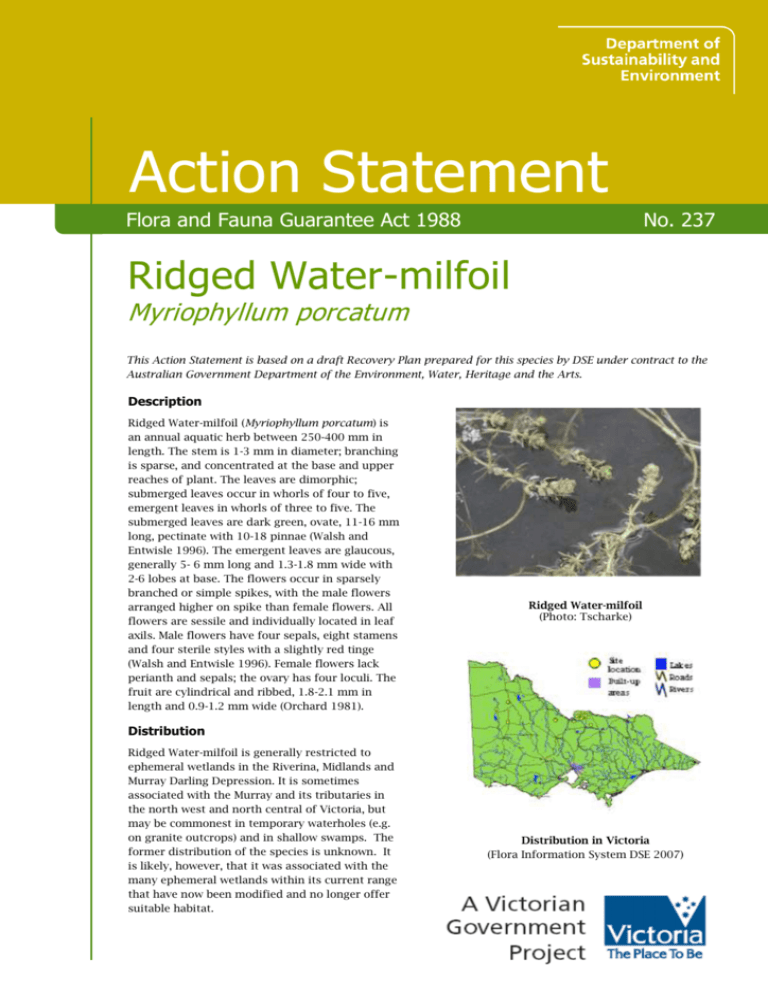
Action Statement Flora and Fauna Guarantee Act 1988 No. 237 Ridged Water-milfoil Myriophyllum porcatum This Action Statement is based on a draft Recovery Plan prepared for this species by DSE under contract to the Australian Government Department of the Environment, Water, Heritage and the Arts. Description Ridged Water-milfoil (Myriophyllum porcatum) is an annual aquatic herb between 250-400 mm in length. The stem is 1-3 mm in diameter; branching is sparse, and concentrated at the base and upper reaches of plant. The leaves are dimorphic; submerged leaves occur in whorls of four to five, emergent leaves in whorls of three to five. The submerged leaves are dark green, ovate, 11-16 mm long, pectinate with 10-18 pinnae (Walsh and Entwisle 1996). The emergent leaves are glaucous, generally 5- 6 mm long and 1.3-1.8 mm wide with 2-6 lobes at base. The flowers occur in sparsely branched or simple spikes, with the male flowers arranged higher on spike than female flowers. All flowers are sessile and individually located in leaf axils. Male flowers have four sepals, eight stamens and four sterile styles with a slightly red tinge (Walsh and Entwisle 1996). Female flowers lack perianth and sepals; the ovary has four loculi. The fruit are cylindrical and ribbed, 1.8-2.1 mm in length and 0.9-1.2 mm wide (Orchard 1981). Ridged Water-milfoil (Photo: Tscharke) Distribution Ridged Water-milfoil is generally restricted to ephemeral wetlands in the Riverina, Midlands and Murray Darling Depression. It is sometimes associated with the Murray and its tributaries in the north west and north central of Victoria, but may be commonest in temporary waterholes (e.g. on granite outcrops) and in shallow swamps. The former distribution of the species is unknown. It is likely, however, that it was associated with the many ephemeral wetlands within its current range that have now been modified and no longer offer suitable habitat. Distribution in Victoria (Flora Information System DSE 2007) Abundance The number of individuals is unknown but total numbers are likely to fluctuate dramatically depending on seasonal rainfall in appropriate habitat. Plants are known to occur in 9-10 populations. The extent of range and abundance of Ridged Water-milfoil prior to European settlement is unknown. Important populations Myriophyllum porcatum is currently known from small, widely separated wetlands, including farm dams, drainage lines on private land, and rock pools and waterholes in granite outcrops and claypans. Unconfirmed anecdotal information suggests that the species may be present in the seed bank of Lake Lascelles and Lake Albacutya (both currently dry). Current populations occur in the following locations: Land Tenure/Reservation Populations National Parks Terrick Terrick National Park, three populations Flora and Fauna Reserves Wathe Flora and Fauna Reserve, two populations Private Land Nathalia, five populations Euroa, six populations Roadside Tongala, one population (possibly extinct) Anecdotal Records (for searching purposes) Lake Lascelles, Hopetoun Lake Albacutya Habitat Myriophyllum porcatum is an aquatic species that occurs in shallow, ephemeral wetlands (including lakes, swamps, rock pools in granite outcrops, waterholes in claypans) and highly modified habitats (including farm dams and drainage lines on private land). Some wetlands, such as Lake Lascelles, are dry for extended periods and only fill intermittently. It is possible that the species may be present in the seed banks of wetlands that are currently dry; such water bodies include Lake Lascelles, which fills intermittently and Lake Albacutya. Life history and ecology Biological and ecological functioning of this species and its habitat have been significantly compromised as a result of the introduction of exotic species and utilisation of these water bodies by stock. Shallow wetlands, the species’ preferred habitat, have been seriously affected by altered water regimes, greatly altering natural flooding and drying regimes. Shallow wetland habitat is now isolated both spatially and temporally. Due to environmental factors such as weather and drainage, some communities will be dry when others are wet, further reducing the ability for genetic exchange to take place. Conservation status National conservation status Ridged Water-milfoil is listed as ‘vulnerable’ under the Commonwealth Environment Protection and Biodiversity Conservation Act 1999. Victorian conservation status Ridged Water-milfoil is listed as ‘threatened’ under the Victorian Flora and Fauna Guarantee Act 1988. It is considered ‘vulnerable’ in Victoria according to DSE’s Advisory List of Rare or Threatened Vascular Plants in Victoria – 2005 (DSE 2005). Potentially threatening processes The following processes are considered to pose a threat to Ridged Water-milfoil: Weed invasion Weed infestation of wetlands threatens Ridged Water-milfoil habitat at most sites. Paterson’s Curse (Echium plantagineum) is a significant problem at Terrick Terrick National Park. Although weed species pose a threat to these populations, their removal may also cause impacts. Damage could result from herbicide drift or chemical accumulation within wetlands. Recreational activities Trail bike riding and recreational vehicle use may threaten populations on reserved land at Wathe Flora and Fauna Reserve and Terrick Terrick National Park. Alteration of water quality This is particularly an issue for agricultural sites where stock have trampled and pugged the soil. Other water quality issues include salinity and runoff from agricultural activities. Further alteration to environmental flows to catchment. Hydrological changes may affect wetlands supporting the Ridged Water-milfoil as a result of low level disturbance on private land or from changes to irrigation infrastructure. For example, hydrological changes may occur as a result of the closure of the channel that once discharged within Wathe Flora and Fauna Reserve. In the longer-term, climate change may lead to the loss of many of these wetlands. 2 Grazing This threat is active on public land in ephemeral wetlands where stock is permitted to graze on dry lakebeds or trample the banks of wetlands. Eutrophication of small water bodies in grazed areas has the potential to degrade otherwise suitable sites. Grazing and trampling by stock also seriously threatens some populations on private land. Previous management action The New Quarry location has been surveyed, plants mapped, counted and threats assessed. Seed has been collected and stored. The Terricks Ridge Landcare group has been funded to control Paterson’s curse, cactus and other weeds surrounding the habitat. Weed control has been undertaken at Terrick Terrick National Park. Annual monitoring has been undertaken. A fact sheet has been published on the DSE website. Negotiations have commenced to incorporate current unreserved Crown land containing Myriophyllum porcatum into Terrick Terrick National Park. Long term objective To ensure that Ridged Water-milfoil can survive, flourish and retain its potential for evolutionary development in the wild. Specific objectives, actions and targets The intended management actions listed below are further elaborated in DSE’s Actions for Biodiversity Conservation (ABC) system. Detailed information about the actions and locations, including priorities, is held in this system and will be provided annually to land managers and other authorities. Objective I To increase knowledge of biology, ecology and management requirements Action Targets 1. Acquire baseline population data. Conduct detailed field assessments including identification of the area and extent of the population, estimates of the number, size and structure of the population, and inference or estimation of population change. Assessments should target Parks Victoria managed reserves and other protected areas. Updated records on all State databases (FIS, VROTPop and Herbarium). Target populations accurately mapped. Assess habitat characteristics and/or condition. Accurately survey known habitat and collect and analyse floristic and environmental information relevant to community ecology and condition. Ecological requirements identified for the completion of essential life history stages. Recruitment and dispersal identified at known sites. Core habitat mapped. 2. Responsible DSE DSE 3. Conduct survey to locate suitable habitat. Identify and survey potential habitat, using ecological and bioclimatic information that may indicate habitat preference. Sites of potential habitat identified and surveyed. DSE 4. Undertake research to identify key biological functions. Evaluate current reproductive / regenerative status, seed bank status and longevity, fecundity and recruitment levels by conducting field based experimental trials. Determine seed germination requirements by conducting laboratory and field trials aimed to identify key stimuli. Regenerative potential quantified at all known sites. Seed bank/regenerative potential quantified for Lake Albacutya, Lake Lascelles and other target populations. DSE, Royal Botanic Gardens Stimuli for recruitment/regeneration identified. Management strategies identified to maintain, enhance or restore 3 regenerative processes fundamental to reproduction and survival. 5. Analyse population trends. Measure population trends and responses against recovery actions by collecting demographic information including recruitment and mortality, timing of life history stages and morphological data. Collate, analyse and report on census data and compare with management histories. Objective II Techniques for monitoring developed and implemented. Annual census data for target populations collected. Population growth rates determined. Population Viability Analysis completed for targeted populations. Determination of requirements for ex situ conservation. DSE To secure populations or habitat from potentially incompatible land use or catastrophic loss. Action Targets 6. Liaise with government agencies. Ensure that information and advice about the recovery of Myriophyllum porcatum has been provided to public land managers, local government authorities and Catchment Management Authorities. All relevant land managers and planning authorities advised of populations and management requirements. DSE 7. Develop or amend planning scheme overlays and schedules. Review the extent to which key sites are protected under local planning schemes. Where necessary, provide information to local councils on which Environmental Significance Overlays could be developed. Key sites are protected under planning schemes. DSE 8. Liaise with private landholders. Ensure that information and advice about the recovery of Myriophyllum porcatum has been provided to private land managers and landholders. All relevant private land managers are aware of the species and its management needs. DSE 9. Negotiate co-operative management agreements with private landholders. Approach landholders at key sites regarding options for voluntary conservation agreements. All relevant landholders approached to undertake voluntary conservation measures. DSE Development of effective propagation and cultivation techniques. At least 250 mature plants from a range of locations in cultivation. Royal Botanic Gardens, Open Range Zoo – Werribee, Parks Victoria 10. Establish cultivated plants ex situ to safeguard from the unforeseen destruction of wild populations. Objective III Responsible To improve the condition of habitat Action Targets 11. Erect/maintain structures to restrict or discourage access. Control threats from pest plants and animals and recreational trail bike riding at Terrick Terrick National Park by fencing and/or placing mesh over water holes and using biological control and the sensitive application of herbicide Stable seedling recruitment / vegetative regeneration at Terrick Terrick National Park and Wathe Flora and Fauna Reserve. Measurable reduction in disturbance to habitat by recreational vehicles. Responsible Parks Victoria 4 (i.e. avoid spray drift, limited herbicide use by spraying at appropriate times). The potential impacts of threat control methods for Ridge Water-milfoil are to be carefully considered and evaluated. Control threats from recreational vehicle driving at Wathe Flora and Fauna Reserve by preventing access and re-routing tracks if appropriate in consultation with stakeholders. 12. Manage environmental weeds. Control threats from pest plants using biological control and the sensitive application of herbicide. Objective IV Stable seedling recruitment / vegetative regeneration at Terrick Terrick National Park and Wathe Flora and Fauna Reserve. Parks Victoria To increase community awareness and support Action Targets 13. Involve community groups and volunteers in recovery activities. Responsible Opportunities for involvement identified, promoted and supported. DSE References Boon, P.I., Davis, J.A. and Froend, R.H. 1997, National Wetlands Research and Development Program Scoping Review, Editors Bunn, S.E. and Schofield, N.J., Land and Water Resources Research and Development Corporation, Canberra Australia. DSE (2005) Advisory List of Rare or Threatened Vascular Plants in Victoria – 2005. Department of Sustainability and Environment, East Melbourne, Victoria. Orchard A.E. (1981) A Revision of South American Myriophyllum (Haloragaceae), and its Repercussions on Some Australian and North American Species. Brunonia 4, 27-65. Walsh N.J.G. and Entwisle T.J. (1996) 'Flora of Victoria.' (Inkata Press: Melbourne) This Action Statement has been prepared under section 19 of the Flora and Fauna Guarantee Act 1988 under delegation from Mr Peter Harris, Secretary, Department of Sustainability and Environment, July 2008. Published by the Victorian Government Department of Sustainability and Environment Melbourne, July 2008 © The State of Victoria Department of Sustainability and Environment 2008 This publication is copyright. No part may be reproduced by any process except in accordance with the provisions of the Copyright Act 1968. Authorised by the Victorian Government, 8 Nicholson Street, East Melbourne. ISSN 1448-9902 For more information contact the DSE Customer Service Centre 136 186 Disclaimer This publication may be of assistance to you but the State of Victoria and its employees do not guarantee that the publication is without flaw of any kind or is wholly appropriate for your particular purposes and therefore disclaims all liability for any error, loss or other consequence which may arise from you relying on any information in this publication. Accessibility If you would like to receive this publication in an accessible format, such as large print or audio, please telephone 136 186, 1800 122 969 (TTY), or email customer.service@dse.vic.gov.au This document is also available in PDF format on the Internet at www.dse.vic.gov.au 5



